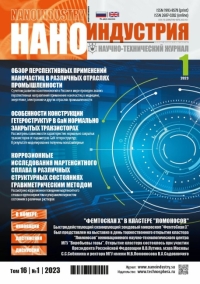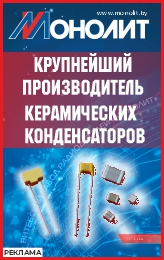CORROSION STUDIES OF THE Ti50.0Ni50.0 MARTENSITIC ALLOY IN DIFFERENT STRUCTURAL STATES BY THE GRAVIMETRIC METHOD DOI: https://doi.org/10.22184/1993-8578.2023.16.1.48.57
The paper considers the corrosion behavior of the Ti50.0Ni50.0 martensitic alloy in coarse-grained and ultrafine-grained states in various solutions. In the coarse-grained state, no significant corrosion damage is observed; corrosion products are clearly visible in a dark field taken with an inverted microscope. In the ultrafine-grained state, significant corrosion damage is observed in the form of pitting which size is several micrometers. X-ray phase analysis of the Ti50.0Ni50.0 alloy made it possible to determine the presence of a high proportion (more than 70%) of TiNiH1.4 hydride in the ultrafine-grained state after corrosion tests while the proportion of hydride in the coarse-grained state is less than 2%. The TiNi alloy contains the Ti2Ni phase enriched with Ti, both in the coarse-grained and ultrafine-grained states. Moreover, in the ultrafine-grained state its share is 6 times higher. In addition, 5.3% of the Ti3Ni3Ox phase is observed in the ultrafine-grained state, while this phase was not found in the coarse-grained state. There is also a phase redistribution of the TiNi matrix in the ultrafine-grained state.
LINEAR NANOMEASURING HOLOGRAPHIC SENSOR DOI: https://doi.org/10.22184/1993-8578.2023.16.1.58.68
Linear nanomeasuring holographic encoder (LNHS) refers to measuring technology, more exactly precisely, to the field of highly accurate measurements of lengths and displacements by linear holographic sensors based on holographic diffraction gratings (HDG), and can be used in mechanical engineering for precision equipment, including machine tools, optical-mechanical and aerospace industry for measuring end standards, etc. Application of such sensors improves accuracy and resolution of LNHS when measuring linear dimensions in the entire measured range of displacements up to a meter or more, regardless of the quality of the guides of the system. Hence, there is an expansion of the range of processed or studied objects while maintaining high accuracy and resolution of the measuring system.
DESIGN FEATURES OF HETEROSTRUCTURES FOR CONSTRUCTION OF GaN NORMALLY-OFF TRANSISTORS FOR POWER MONOLITHIC INTEGRATED CIRCUITS DOI: https://doi.org/10.22184/1993-8578.2023.16.1.70.79
This paper considers the key dependencies of characteristics of the normally-off transistors on GaN heterostructures parameters. Thicknesses and concentrations of dopants in the layers of the heterostructure are determined. As a result of the simulation, the current-voltage characteristics of a p-channel field-effect transistor and an n-channel transistor with a p-type gate layer were obtained.
SCIENTIFIC BREAKTHROUGH. JANUARY THESES DOI: https://doi.org/10.22184/1993-8578.2023.16.1.8.12
The Advanced Technologies Center has been working for over 30 years on probe microscopy, which allows to see cells, bacteria, viruses, and even atoms and molecules. At the Physical department of Moscow State University, with the support of the Moscow government, the Youth Innovation Creativity Centre "Nanotechnology" was established, where schoolchildren and students learn how to use a 3D nanomicroscope, computer numerical control machines (CNC machines), 3D printers and a laser engraver. At the YICC, we talk about nanotechnology and why we need to build factories. This activity will continue in the Lomonosov cluster.
FEMTOSCAN X AT THE LOMONOSOV CLUSTER DOI: https://doi.org/10.22184/1993-8578.2023.16.1.14.18
The fast scanning probe microscope FemtoScan X was presented at the exhibition on the day of the Lomonosov cluster grand opening in Science and Technology Innovation Center "Vorob'evy Gory" at MSU. The cluster was opened on 25 January, 2023 in the presence of Russian President Vladimir Putin, Moscow Mayor Sergey Sobyanin and Rector of Lomonosov Moscow State University Viktor Sadovnichy.
A METHODOLOGY FOR DEVELOPMENT OF THIN-FILM SYSTEMS WITH DEFINED GAS SENSITIVITY REQUIRING NO POWER SOURCES AND INTENDED FOR CHEMORESISTIVE GAS SENSING DOI: https://doi.org/10.22184/1993-8578.2022.16.1.22.28
A methodology for development of thin-film systems is presented, which will make it possible to obtain chemoresistive sensors with a given gas sensitivity. The methodology provides for conducting a series of experiments on the thin-film systems synthesis using various synthesis technologies (different starting materials, parameters of thin films synthesis, various methods of thin films synthesis: thermoresistive evaporation, air-drop sputtering, annealing in oxygen atmosphere), measuring their properties and characteristics, creating a database of experimental results; generalization of the dependencies contained in the experimental data using artificial neural networks in the form of multifactorial computational models. These models will make it possible to solve direct and inverse problems, extrapolate the dependencies revealed in the experimental data, and conduct virtual experiments.
REVIEW OF THE PROMISING APPLICATIONS OF NANOPARTICLES IN VARIOUS INDUSTRIES DOI: https://doi.org/10.22184/1993-8578.2023.16.1.30.40
The authors analysed the promising applications of nanoparticles in various fields, such as medicine, energy production, electronics and other industries taking into account the development of nanotechnology in Russia and worldwide.
NEW GREEN, NATURE-LIKE TECHNOLOGIES FOR THE BIOSYNTHESIS OF NOBLE AND HEAVY METAL NANOPARTICLES DOI: https://doi.org/10.22184/1993-8578.2023.16.1.42.47
The production of nanoparticles (NM) and metal nanoparticles (MPM) are among the main areas in nanotechnology (NT), as NM, like all NT, is interdisciplinary in nature and, actually, intersectoral in use. Among all types of NF, NFMs occupy an important place and they are very widely used in various fields of science and technology: medicine (therapy, diagnosis), environmental protection, catalysis, agricultural engineering, product packaging, antimicrobial treatment, etc. Our series of articles will cover the methods of NMFs production and their application in various fields of medicine (wound healing, oncology, treatment of bacterial and viral diseases). In this paper we will focus on the methods of the NMFs production and, above all, on the biosynthesis of noble and heavy metal NMFs.

 rus
rus


